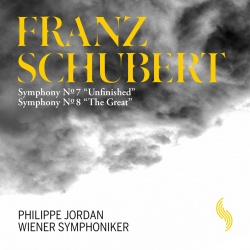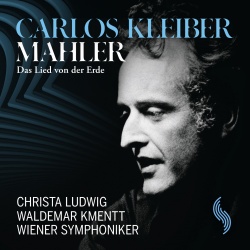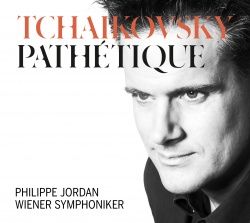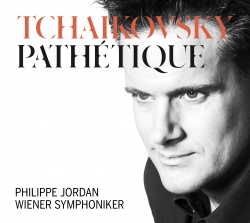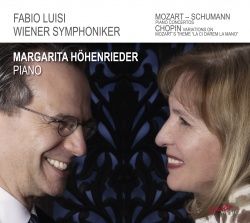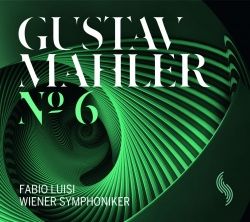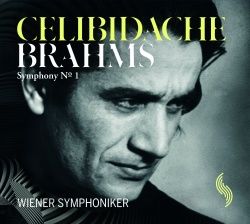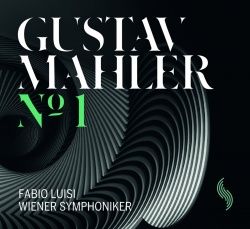Wiener Symphoniker – Franz Schubert – Symphonie Nr. 7
Artists: Wiener Symphoniker
Title: Franz Schubert – Symphonie Nr. 7 “Unvollendete” – Symphonie Nr. 8 “Grosse C-Dur”
Catalogue No.: WS009
Release: 21.08.2015
Description
Philippe Jordan has already established himself as one of the most gifted and exciting conductors of his generation. At present, he is Music Director of the Opéra National de Paris and Music Director of the Wiener Symphoniker.
Tracklist
| Symphony No. 8 in C major D 944 „Great C major“ Symphonie Nr. 8 C-Dur D 944 „Große C-Dur“ |
|
| Andante. Allegro ma non troppo | 15:53 |
| Andante con moto | 13:53 |
| Scherzo. Allegro vivace – Trio | 12:48 |
| Finale. Allegro vivace | 11:47 |
| Symphony No. 7 in b minor D 759 „The Unfinished“ Symphonie Nr. 7 h-moll D 759 „Die Unvollendete“ |
|
| Allegro moderato | 14:38 |
| Andante con moto | 10:45 |
| Total Running Time | 79:46 |
Wiener Symphoniker – Antonin Dvorak – Symphonie Nr. 9 e-moll
 Artists: Wiener Symphoniker, Karel Ancerl
Artists: Wiener Symphoniker, Karel Ancerl
Title: Antonin Dvorak – Symphonie Nr. 9 e-moll – Aus der Neuen Welt
Catalogue No.: WS008
Release: 27.04.2015
Description
Czechoslovakia, rather, wherever he was in the world, he spread his very own humanistic attitude. Yet he never forgot his Bohemian roots. He championed the unpopular oeuvre of Bohuslav Martinů in equal measure to being honoured for his sublime interpretations of works by Leoš Janaček. To this day, his recordings of the music of Antonin Dvořak stand as expressive testaments in sound to a hard-won identity.At the height of his post-war European career, Ančerl liked to visit his friends at the Wiener Symphoniker; not only for 23 concert performances with them by 1970, but above all to record, with them, the epitome of musical freedom. Thus Dvořak’s Ninth, the Symphony in e minor op. 95, really does sound like it comes From the New World. From a beautiful, new world that is proof of the universality of art, that is radiant in a belief in beauty, harmony and humanity. A radiance that could hardly travel more directly from the recording to the hearts of an uplifted audience. So it does exist after all in the world, something simply good …
Reporting on the premiere of the new symphony by the New York director Antonin Dvořak, the American press immediately called it a gift of true “American music”. Friend and musician Josef Jan Kovařik did in fact give an account of the completion of the score before the first performance on 16 December 1893 in New York’s Carnegie Hall, telling that, “before I set off with the score, at the last moment, the maestro [wrote] ‘From the New World’ on the title page.” Discussions both within America and internationally were, from the beginning, wide-ranging. Dvořak himself denied the intentionality of any possible ethnic associations, although he did indeed incorporate elements of Native American folklore –albeit enriched with song and dance tunes from his beloved Bohemian homeland.
Historical Recording – Recording location: Vienna, Musikverein – 8–10 February 1958
Tracklist
Symphony No. 9 in e minor “From the New World”
Symphonie Nr. 9 e-moll „Aus der Neuen Welt“
1 Adagio – Allegro molto 09:04
2 Largo 09:45
3 Scherzo. Molto vivace 07:32
4 Allegro con fuoco 11:00BEDŘICH SMETANA (1824 – 1884)
From “Má vlast” (“My Country”), Cycle of six symphonic poems
Aus „Má vlast“ („Mein Vaterland“), sechs symphonische Dichtungen
5 „Vltava“ („Die Moldau“) 11:40
Wiener Symphoniker – “Das Lied von der Erde”
Artists: Wiener Symphoniker
Title: “Das Lied von der Erde” – Symphony for tenor, alto and Orchestra
Catalogue No.: WS 007
Release: 13.10.2014
Description
Past releases of this particular Das Lied von der Erde recording have received high praise in various Kleiber internet forums. But owing to the fact that needed adjustments and final editing did not take place, these recordings were of such poor quality that knowledgeable Kleiber fans simply could not listen to them. Judging by the condition of the source material, we were working with a second or even a third generation of the original recording. In this regard, however, several traps inevitably lay in store for the person charged with remastering. This was the second important and challenging assignment for our recording engineer; it follows on the heels of Celibidache‘s rendition of Brahms, which appeared as WS 002 on the Wiener Symphoniker label. To bring new life to this historic recording, which cognoscenti considered very marginal and barely listenable, was certainly our challenge.
Tracklist
| Das Trinklied vom Jammer der Erde | 8:35 |
| Der Einsame im Herbst | 9:10 |
| Von der Jugend | 3:04 |
| Von der Schönheit | 6:37 |
| Der Trunkene im Frühling | 4:14 |
| Der Abschied | 26:50 |
| Total Running Time | 58:40 |
Wiener Symphoniker – Tschaikowsky – Symphonie Nr. 6
Artists: Wiener Symphoniker
Title: Pjotr Iljitsch Tschaikowsky – Symphonie Nr. 6
Catalogue No.: WS 006
Release: 08.09.2014
Description
Doctors interviewed by the newspapers also confirmed the cause of death as uremia due to cholera. But soon there were an increasing number of medically corroborated dispatches that hardened suspicions of premeditation and even spoke of suicide by poison. Then the idea of the Symphony in B minor as a requiem for himself began to circulate, and a myth was born.
December 14, 2013: A recording session in the Golden Hall of the Vienna Society of the Friends of Musicmarks the dawn of a new era for the Wiener Symphoniker. The history of this traditional Viennese orchestra is filled with 282 celebrated performances of P. I. Tchaikovsky’s Pathétique. And now the orchestra’s new chief conductor Philippe Jordan will show what he’s made of by interpreting this highly significant work. The orchestra’s intense involvement with Tchaikovsky’s Sixth began in 1903 with the legendary Russian conductor Vasily Safonov and the previous ensemble, the Wiener Concertverein.
Other colleagues of equal stature absolutely demonstrated their abilities by way of this final opus: Seiji Ozawa, Václav Neumann, Yakov Kreizberg, Hans Knappertsbusch, Otto Klemperer, Karl Böhm, Sergiu Celibidache, Lorin Maazel, and nearly every chief conductor of the Wiener Symphoniker, including Herbert von Karajan, Wolfgang Sawallisch, Carlo Maria Giulini, Georges Prêtre, Rafael Frühbeck de Burgos, Vladimir Fedosejev, and Fabio Luisi.What particular aspect(s) will Philippe Jordan emphasize? The mystical aspect? The hopeful secondary themes? The harsh fate that reveals the inexorable power of destiny? Maestro Jordan has been preparing for this great task with incredibly precise attention to detail.As a result, listeners can enjoy every facet of Tchaikovsky’s life [and work], no matter how small.
Tracklist
2. Allegro con grazia
3. Allegro molto vivace
4. Adagio lamentoso – Andante
Wiener Symphoniker – Johann Strauss
Artists: Wiener Symphoniker
Title: Johann II, Josef und Eduard Strauss
Catalogue No.: WS 005
Release: 23.06.2014
Description
In the numerous establishments of the Viennese suburbs, the ensembles of rivaling bandmasters Joseph Lanner (1801 – 1843) and Johann Strauss I (1804 – 1849) publicly played dance music and hence they may be considered as the actual„inventors“ of the Viennese Waltz as it is commonly understood and loved all over the world today.
After the early death of Johann Strauss Sr., his oldest son Johann (1825 – 1899), the „Waltz King“, assumed leadership of the orchestra and diversified the area of activity significantly. The youngest of the sons of Strauss Sr., Eduard (1835 – 1916), also trained as a musician and joined his brother‘s ensemble at the age of 20. The middle son, Josef (1827 – 1870), had different plans for his life and became a technician. However, when in 1852 his brother returned from a concert tour completely exhausted, Josef needed to step in as conductor of the Strauss orchestra the following year. He composed his first waltz, believing it would be his last. Nevertheless, as his brother Johann travelled abroad more and more frequently, Josef needed to substitute for him in Vienna. At the same time, he took violin lessons, learned to compose properly and thus became a musician as well. As a composer he was certainly on par with his older brother. His dances often display a certain wistfulness and sometimes seem to come straight from Schubert.
This CD unites compositions of all three sons of the Strauss dynasty‘s founder.
Tracklist
2 Josef Strauss: „Die Libelle“, Polka mazur op. 204
3 Johann Strauss II: „Furioso“, Polka quasi Galopp op. 260
4 Eduard Strauss: „Die Biene“, Polka française op. 54
5 Josef Strauss: „Dorfschwalben aus Österreich“, Walzer op. 164
6 Johann Strauss II: „Im Krapfenwaldl“, Polka française op. 336
7 Johann Strauss II: „Auf der Jagd“, Polka schnell op. 373
8 Johann Strauss II: „Rosen aus dem Süden“, Walzer op. 388
9 Johann Strauss II: „Tritsch-Tratsch“, Polka schnell op. 214
10 Josef Strauss: „Feuerfest!“, Polka française op. 269
11 Johann Strauss II: „Frühlingsstimmen“, Walzer op. 410
12 Johann Strauss II: „Unter Donner und Blitz“, Polka schnell op. 324
Wiener Symphoniker: Anton Bruckner – Sinfonie Nr.2
Artists: Wiener Symphoniker
Title: Anton Bruckner – Sinfonie Nr.2 in C Moll (1877 version)
Catalogue No.: WS 004
Release: 05.05.2014
Description
Our time with Giulini was not very long but most of us enjoyed it. Our highlyesteemed Chief Conductor of the 1970s, who understood how to make such an important and prize-winning recording from this rarely-played Bruckner symphony – what better gift on the occasion of his 100th birthday than a reissue of this record from 1974?
Tracklist
I Moderato
II Andante – Feierlich, etwas bewegt
III Scherzo – Mässig schnell
IV Finale – Mehr schnell
Margarita Höhenrieder, Wiener Symphoniker – Klavierkonzerte
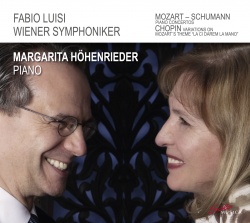 Artists: Margarita Höhenrieder, Wiener Symphoniker
Artists: Margarita Höhenrieder, Wiener Symphoniker
Title: Klavierkonzerte Schumann & Mozart – Variationen Chopin
Catalogue No.: SM 189
Release: 20.01.2014
Description
Margarita Höhenrieder and the Vienna Symphony Orchestra with Fabio Luisi are playing on this Studioalbum the most famous piano concertos by Mozart, Schumann and the Chopin Variations from Don Giovanni.
The CD was recordedat the Konzerthausin Vienna.
Margarita Höhenrieder, an outstanding pianist from Munich, rarely performs in concerts. She is little known to the general public but highly respected among experts. She has been invited to perform as a soloist by the conductors Claudio Abbado, Riccardo Chailly, James Levine, Fabio Luisi, Lorin Maazel as well as by renowned orchestras such as the Symphony Orchestra of Bavarian Radio, the Munich Philharmonic Orchestra, the Staatskapelle of Dresden, the Gewandhaus Orchestra of Leipzig, the Mozarteum Orchestra of Salzburg, the Mahler Chamber Orchestra and the New York Philharmonic.
Margarita Höhenrieder also owes some essential musical inspiration to her friendship and cooperation with Alfred Brendel.
Tracklist
Piano Concerto A Major KV488Robert Schumann
Piano Concerto a minorFrédéric Chopin
Variations op. 2 “Là ci darem la mano” de “Don Juan” de Mozart
Wiener Symphoniker – Gustav Mahler – Symphony No. 6
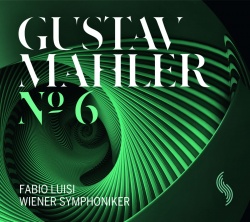 Künstler: Wiener Symphoniker
Künstler: Wiener Symphoniker
Titel: Gustav Mahler – Symphony No. 6
Katalog Nr.: WS 003
Veröffentlichung: 18.02.2013
Produktbeschreibung
Live – Aufnahme aus dem großen Saal des Musikvereins in Wien
Mit Gustav Mahlers Symphonie Nr. 6 in a-moll veröffentlicht das Label „Wiener Symphoniker“ eine weitere denkwürdige Aufnahme als Doppel-CD.
Aufgenommen unter der Leitung von Chefdirigent Fabio Luisi, steht diese Symphonie in einem direkten, historischen Bezug der Wiener Symphoniker zum Komponisten: die Wiener Erstaufführung der 6. Symphonie fand mit den Wiener Symphonikern – damals noch unter ihrem Gründernamen „Wiener Concertverein“ – und Gustav Mahler selbst am Dirigentenpult statt.
Ort dieser Premiere am 4. Jänner 1907 war der Große Saal des Musikvereins Wien. Bemerkenswerte geschichtliche Notiz am Rande: auf dem Programmzettel zu diesem Konzert findet sich der später gebräuchliche Beinamen „Tragische“ wieder – ganz im Gegensatz zur ebenfalls von Mahler geleiteten Uraufführung in Essen und dem Folgekonzert in München im Jahr zuvor. Offensichtlich stammt diese Ergänzung nicht vom Komponisten, wurde aber von diesem für das Konzert in Wien akzeptiert.
94 Jahre danach bildet der Musikverein Wien wiederum den Rahmen dieser spannungsgeladenen Liveaufnahme aus dem Jahre 2011, die sich an der von Gustav Mahler autorisierten Satzfolge – Andante vor dem Scherzo – orientiert.
Tracklist
CD 1
1. Allegro energico, ma non troppo. Heftig, aber markig
2. Andante moderato
CD 2
3. Scherzo. Wuchtig
4. Finale. Allegro moderato
Wiener Symphoniker – Johannes Brahms – Symphony No. 1
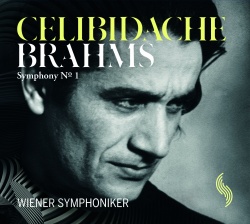 Künstler: Wiener Symphoniker
Künstler: Wiener Symphoniker
Titel: Johannes Brahms – Symphony No. 1
Katalog Nr.: WS 002
Veröffentlichung: 19.11.2012
Produktbeschreibung
Die Restauration der vorliegenden Monoaufnahme von 1952 – war einerseits wegen Alterungsprozesse eines fast 60 Jahre alten Magnetbandes schwierig und aufwändig , zum anderen ist das historische direkte Mono-Klangbild mit heutigen stereophonen Hörgewohnheiten kaum vermittelbar, es sei denn man beschränkt sich auf den rein dokumentarischen Wert. Nun gab es bereits in den 70iger Jahren eine kurze Ära in der Plattenindustrie alte Monoaufnahmen mit einem elektronischem Stereo zu versehen. Leider war diese Technik damals unbefriedigend und die Ergebnisse waren so niederschmetternd schlecht, dass sich eigentlich Tonmeister heute noch für diesen Schwachsinn entschuldigen sollten… Hier wurden tatsächlich wichtige historische Dokumente und musikalische Zeitzeugen der Tonkunst “verstümmelt”. In den letzten Jahren wurden in der digitalen Studiotechnik jedoch brauchbare Handwerkszeuge entwickelt, die es Tonmeistern erlauben hier sehr kreativ auch räumliche Dimensionen einer Monoaufnahme in ein stereophones Umfeld herauszuarbeiten, zudem neue Filtertechniken es ermöglichen nichtlineare Verzerrungen zu eleminieren und damit eine kostbare historische Aufnahme auch klangästhetisch wieder hörenswert. dem Musikhörer zugänglich zu machen.
Tracklist
Johannes Brahms – Symphony No. 1
1. Un poco sostenuto – Allegro
2. Andante sostenuto
3. Un poco Allegretto e grazioso
4. Adagio – Più Andante – Allegro non troppo ma con brio – Più Allegro
Wiener Symphoniker – Mahler Symphony No. 1
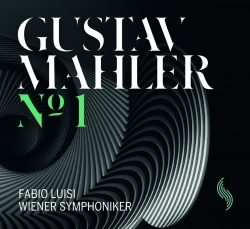 Künstler: Wiener Symphoniker
Künstler: Wiener Symphoniker
Titel: Mahler Symphony No. 1
Katalog Nr.: WS 001
Veröffentlichung: 08.10.2012
Produktbeschreibung
Das traditionsreiche Konzertorchester der Stadt Wien präsentiert die erste Produktion unter seinem neu gegründeten Eigen-Label “Wiener Symphoniker”. Ziel des neuen Labels ist es, im zunehmend auf Stars und Sternchen zugeschnitten Klassik-Tonträgermarkt bewusst den Fokus auf seriöse, programmatisch bewusst gesetzte Aufnahmeprojekte mit höchsten Qualitätsansprüchen zu setzen.
Paradigmatisch und stellvertretend für das Kernrepertoire der Wiener Symphoniker steht das Werk der ersten Veröffentlichung Gustav Mahlers 1. Symphonie in D-Dur entstand in ihrer heute gespielten Form nur 4 Jahre vor der Gründung der Wiener Symphoniker im Jahr 1900. Dementsprechend bildeten die Symphonien Gustav Mahlers von Anbeginn einen Schwerpunkt in der interpretatorischen Auseinandersetzung des Orchesters unter vielen namhaften Dirigenten. Mahlers Symphonie „Nr. 1“ ist darüber hinaus als Erstlingswerk eines in Wien wirkenden Revolutionärs mehr als passend für den Start eines neuen Wiener Orchester-Labels.
Zukünftig wird das Label „Wiener Symphoniker“ jährlich zwischen 2 und 4 Produktionen auf den Markt bringen. Zum einen handelt es sich um neue, Großteils live produzierte Aufnahmen, andererseits aber auch um Archiv-Mitschnitte aus der an Höhepunkten reichen Geschichte des Orchesters. Als nächste Veröffentlichungen sind Gustav Mahlers Symphonie Nr. 6 (Fabio Luisi) und die 1. Symphonie von Johannes Brahms (Sergiu Celibidache) vorgesehen.
Tracklist
| Symphony No. 1 in D major | Gustav Mahler | |
| 1. Langsam, schleppend. | ||
| Im Anfang sehr gemächlich | 15:35 | |
| 2. Kräftig bewegt, doch nicht zu schnell | 08:42 | |
| 3. Feierlich und gemessen, ohne zu schleppen | 11:18 | |
| 4. Stürmisch bewegt | 20:21 | |
| Total | 0:55:57 |
- 1
- 2

